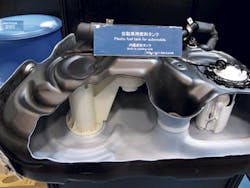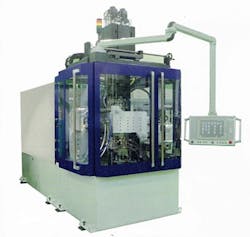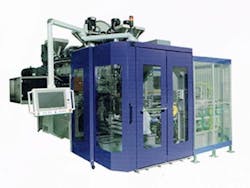Japanese manufacturers of blow molding equipment rolled out new technology for making large and multilayer parts, as well as developments in machinery and parison-control technology in October during the International Plastic Fair (IPF) in Tokyo.
JSW SHOWS ADVANCES IN FUEL TANK MOLDING
The blow molding division of Japan Steel Works (JSW) developed an insert blow molding process for making automotive fuel tanks that eliminates downstream steps.
JSW developed its Built-in-Molding method to produce a fuel tank complete with sensor equipment. The devices installed inside the tank collect and transmit fuel data to the instrument panel of the vehicle.
Typically, the processor would cut open a section of the outer wall of the fuel tank, insert the equipment and seal the opening in a downstream operation.
With JSW's new Built-in-Molding process, the insert is placed within the parison before it is blown into a fuel tank, said Shoji Abe, GM of the industrial machinery group.
A key development of Built-in-Molding is a mechanical pedestal that transports the insert to a position underneath the parison.
The pedestal is positioned inside the guarding of the blow molding machine. The blow molding machine controls its movement. The pedestal moves from an idle position where it receives the insert to an area between the open halves of the mold, directly underneath the forming parison. The top of the pedestal then moves upward, driven by a piston, away from its base. This allows the hollow parison to drape over the pedestal and the insert.
The mold halves come together, enclosing the insert within the parison. The top of the pedestal retracts, the mold halves are clamped together and the parison is blow molded into shape.JSW has developed a second approach for Built-in-Molding. In this twin-sheet method, the parison is cut in two as it comes out of the die head and is rejoined prior to blowing.
This second method is geared to blow molders requiring a thicker-gauge part. The twin-sheet approach introduces a center mold component that is positioned between the two halves of the mold. The center mold component heats the two halves of the parison. Each of the two halves are formed into an intermediate shape around the center component.
The system then removes the center mold component and places the insert. JSW calls this step the setting of built-in parts. The sheets come together when the mold halves are closed, Abe said.
Fuel tanks produced by Built-in-Molding exhibit improved resistance to fuel permeation and are suited for use in hybrid vehicles.
DEVELOPMENTS IN PARISON CONTROL, 3-D BLOW MOLDING
JSW also developed a new parison thickness control for plastic fuel tank production that provides greater versatility and control over final product dimensions compared to conventional parison control. The company's new 4+2 parison control provides enhanced thickness control of the radial wall of a blow molded part.
A conventional parison control system may feature a single die-slide actuator that can control two axes of thickness. JSW's new parison controller has two die-slide actuators that control four axes, Abe said. A 4+2 controller can control the thickness of parisons with particularly thick walls more consistently.
JSW said the new parison thickness controller is available for the first time for plastic fuel tank production as an option on its PFT series of multilayer accumulator blow molding machines.
At the show, JSW also discussed its new 3-D multilayer blow molding machine, designed for manufacturing products such as pipe and other industrial hollow parts.
The NTVB10-2 is a double-station extrusion blow molding machine capable of producing seven-layer parts from five different materials.
The machine takes up about 23 feet by 21 feet by 18 feet and has a mold platen size of about 39.4 inches by 63 inches. Each platen can handle a mold half weighing up to 3,308 pounds. Its crosshead die handles throughputs of up to 119 pounds per hour.
A die-slide wall-thickness control unit is optional with the machine, Abe said.
As a new option for its blow molding machines with tie bars, JSW also announced that it is developing a clamping system that uses both hydraulics and electric motors to close the mold.
The company previously had developed a hybrid clamping system for its tie-bar-less machines. The technology yields energy savings and faster mold closing speeds, he said.
The hybrid clamping system for tie-bar machines will incorporate a proportional valve and servo motor, similar in design to the configuration the company has used on tie-bar-less models.
The hybrid clamping sytem will offer a mold opening/closing speed of 400mm per second. It will use half the energy of a hybrid clamping system on a tie-bar-less machine and provide mold-positioning accuracy and repeatability of plus or minus 0.5mm, Abe said. Tie-bar machines with the new hybrid system will be available in the U.S. at the end next year.
TAHARA COMBINES INJECTION, EXTRUSION BLOW MOLDING
Tahara Machinery launched its HPS series of machines, which combines injection molding with extrusion blow molding and is designed to produce complex blow molded parts with extremely precise neck shapes, said Ryohei Tamura, who is part of Tahara's overseas business team.
According to Tahara, the machine is different from the company's extrusion blow molding machines in that it is suited for the production of automotive, cosmetic and medical products that require precise tolerances. The new HPS series is equipped with an electric control and electric drives.
In this system, the blow head creates the parison so that its leading edge forms the top of the part. In traditional blow molding, the leading edge of the parison drops down to form the bottom of the part. This reversed forming eliminates the potential for parison draw-down, which can impact wall uniformity of the part. Tahara said it is easier to control the wall thickness with the reverse forming step. However, molding cycle times can be longer because of the upward motion of the die head during parison formation, Tamura said.
At IPF, Tahara showed an HPS-50E/05B(T2) model that produced a bellows for the gearshift on a vehicle with manual transmission. The neck of the part was formed by injection molding while the body and bottom of the part were formed simultaneously by blow molding, using a single, innovative mold, Tamura said. The wall of the injection molded neck is thicker than the wall of the blow molded body.
The blow molding head is key to molding the part. In the first step, the blow molding head — which produces the parison — is filled with molten resin. In the second step, an accumulator pushes the material collected in the blow molding head into the mold through an injection pin.
The two halves of the mold then close around a central, cylindrical mold component. As a result, the neck of the part features a hollow center with a uniform injection molded wall. While the neck of the part is cooling in the mold, the remainder of the material being pushed out of the blow molding head forms the extruded parison. The mold halves capture the parison, then an air-blowing pin creates the blow molded portion of the part. A cutting device deflashes material from the blow molded part.
The ability to produce the mouth or top of the part via injection molding eliminates the possibility of mouth flash, which can significantly reduce material costs.
Tahara incorporated a new swing-type screen changer in the extruder section of the HPS-50E/05B(T2) for faster, smoother screen changes with minimal pressure drop. The work cell at IPF featured an industrial SCARA robot for part takeout. The design of the machine allowed the robot to be integrated without increasing the footprint of the manufacturing cell.
Features of the HPS-50E/05B(T2) include a 50mm screw with a 28-to-1 L:D ratio and a throughput of 110 pounds per hour. The accumulator die head can produce two single-layer parisons, with a center distance of 6.7 inches between each parison. The head has a stroke of 2.4 inches and injection speed of 0.8 inches per second. The machine delivers a clamping force of 5.5 tons and has an opening distance of 11.8 inches. It handles mold halves up to 15 inches wide, 11 inches high and up to 4.7 inches thick, Tamura said.
MULTILAYER UNIT ENHANCED
Tahara also updated its HES fully electric multi-layer extrusion blow molding machine series with improved part cooling and Industry 4.0 connectivity. The line produces a single, six-layer parison from six extruders, then provides internal and external post-mold cooling, as well as deflashing, a product weight check and takeout in one molding cell.
An HES C66V/07AJ(C1) model at IPF produced a 2-liter, 190-gram wide-mouth mayonnaise jar from a six-layer parison. The molding cell featured a single post-mold cooling station inside the blow molding machine and a three-station post-mold cooling mechanism outside the machine. Together, they provide consistent and adjustable part cooling. The external cooling stations are compact and require less real estate than a conveyor line or cooling tunnel, Tamura said.
The machine also features a new controller with a 19-inch touch-screen monitor and Internet of Things (IoT) functionality. The controller also has a new remote maintenance function that allows a Tahara technician to remotely access the machine for troubleshooting.
Mikell Knights, senior staff reporter
For more information
Japan Steel Works America Inc.,Farmington Hills, Mich., 248-536-0288, www.jsw.co.jp/en/
Tahara Machinery Ltd.,Tokyo, 81-3-3680-2131, www.tahara-mc.com/en/



